
This year's Southern Appalachia Railway Museum Rare Mileage trips would be in the Pacific Northwest. Bart Jennings tried his best to arrange a really great rare mileage trip, but local problems wiped out that idea, but settled for three one-day trips. The first would on the Port of Tillamook Bay Railroad, the second would be on the Chehalis-Centralia Railroad and the third on Tacoma Rail lines. Those would return me to three lines that I had partially ridden in summer of 2005. On the POTB, my camera died, on the Chehalis-Centralia, I rode only as far as Milburn; and on Tacoma Rail, I had ridden from Elbe to Morton on the Mount Rainier Scenic Railroad.
Jim Nowell had wanted to join me on a trip so I told him about it and he decided to come. Chris Parker also wanted to join us and later, Bob Riskie decided he would also. I made the hotel reservations for Jim and I, then Chris did the same thing for he and Bob. Jim took care of the rental car then we all made our own airline reservations with Jim and I on the same flight, Chris flying solo and Bob using his pass on Amtrak to Portland. As I planned this trip, Southern Pacific 4-8-4 4449 announced that it would be going to Sherwood, Oregon and then Spokane, Portland and Seattle 4-8-4 700 would be going to Oaks Park to give rides on June 10th. That would work since we would be in the Portland area that weekend. There would be a few other surprises that I would spring on our group later on.
Alaska Airlines 491 6/5/2006This was the first time I had been to John Wayne Airport (Orange County) twice in one day. After working at McFadden Intermediate, I drove to the airport to pick up my mother, who was returning from an Alaska cruise. I arrived home and did not find an absentee ballot in the mail. Since I was leaving that evening and tomorrow was election day, I wondered what had happened so called the election offical, Claudia Alvarez, in Santa Ana and was told that I had already voted, which I had not. Could this be a case of voter fraud? I was then given the Orange County Voter Registration Office phone number, told them my story and they told me to be at their office by 5:00 PM in order to vote. I was there eleven minutes later and finished voting by 4:58 PM and was out the door at 4:59 PM. By doing that, I kept my streak of voting in every election since I turned 18.
My mother and I then went to the Steer Inn for dinner where she told me about her cruise and a few of the shore excursions. I checked my e-mail and finished packing before she drove me back to the airport and was there by 7:20 PM, walked through security and arrived at Gate 13. While waiting, I listened to "Honkin' on Bobo" by Aerosmith then found Jim Nowell and we talked until boarding a 737-700 plane at 8:30 PM and settled in for the flight to Portland. We lifted off early at 8:49 PM and had a peaceful flight as I read the new Railfan and Railroad magazine and Jim read my new Trains magazine. We cruised north at 40,000 feet before slowly descending into Portland, touching down at 10:43 PM. Jim and I walked through the airport to Hertz, where Jim rented a Chevy Impala. Chris and Bob joined us; Chris had a good flight but Bob's trip on the Coast Starlight was over five hours late. Other than a traffic jam due to night-time construction on Interstate 205, our Mapquest directions guided us to the Dunes Motel in Hillsboro for our two-night stay, where we checked in and called it a night since it was now after midnight and the day of our first rare mileage trip.
6/06/2006
The Dunes Motel in Hillsboro. I arose and went for a walk.

I found the MAX light rail tracks two blocks away with a Tri-Met train at the Hillsboro station waiting to go east. Back at the motel, our "Fabulous Four" met in the parking lot before going to MacDonald's for a breakfast of sausage and hot cakes then drove out to Banks. There, two things were the same from last July at the National Railway Historical Society convention. The Portland and Western was switching and my 35 mm. camera was giving me problems again. Thank goodness I had the Trainweb.com digital camera.

Maersk SDP40F 644, ex. BNSF 6976, exx. ATSF 6976, nee Amtrak 644 1974 built by Electro-Motive Division in 1974, was being used as part of the Portland and Western trainset.

Later, our train arrived with Port of Tillamook Bay SD9s 4432 and 4405, observation car 2955 "James J. Gilmore", Willamette and Pacific coach PNW 6200, POTB RDC-1 552, Willamette and Pacific baggage car 262 and Willamette and Pacific open car 5601.
A Brief HistoryThe Tillamook Branch of the Southern Pacific was originally going to be an Astoria to Willamette Valley Line. The line was surveyed and graded west of Hillsboro in 1902-1904. On October 13th, 1905 the Pacific Railway & Navigation Company took over the line and changed the line's final destination to Tillamook. In 1906 the line reached Buxton and in 1909 reached Wedeburg. Tillamook to the west end of Mohler was constructed during 1910. Between Wedeburg and Mohler, it took between 1909 and 1911 to construct the line which included eleven tunnels and several high trestles in the deep Coast Range canyons. The entire line was opened on November 1st, 1911. On that same date the Southern Pacific Railroad took over full control of the Pacific Railway & Navigation Company. Logging became and remained the main staple of the line until the 1930's when the Depression hit.
Between 1931 and 1933 three disastrous forest fires burned throughout the Coast Range. The third of these fires was known as the Tillamook Burn which consumed over twelve million board feet of prime timber. The logging industry rebounded from the depression with the salvaging of the burnt timber generating thousands of loads. Passenger service was well used until all weather highways entered the area. In 1932 the passenger train became a mixed train which ran until 1953. In the 1950's, the emphasis switched from hauling logs to finished lumber and wood chips. The Port began operating from Tillamook to Batterson, the midway point on the line, in 1983 from the Southern Pacific. When the SP decided to abandon the line, the Port was able to purchase the entire line to Schefflin with help from the state lottery in 1990. Traffic includes lumber, forest products, aggregates and grains. Excursion trains also are operated by the railroad.
The Trip
Our train departed at 8:50 AM, with me in the open car, and ran a few miles along West Dairy Creek. Elizabeth Davidge, whom I had met at last year's NRHS convention, was here on her first rare mileage excursion, after I had let her know of this week's three trips. She took a week off work and drove from her home in Victoria, British Columbia, to Beaverton then over to Banks to participate.

Members of our group were in the open car with Bart Jennings in the orange trip shirt. As we neared Manning, the train started climbing steadily away from the valley floor along the side of a hill and we left the ranching areas for the dense forest.


At Milepost 782.13, we crossing the first curved wooden trestle over Williams Creek which was 225 feet long.

A few minutes later, after the old station location of Scofield, we crossed another wooden trestle at Milepost 787.7, this time over the Sunset Highway (US 26) and the West Fork of Dairy Creek. Our train continued to climb, curving to gain elevation. At Milepots 788.02, we curved over a third wooden trestle at Capehorn Creek before running through an area of clear-cut timber with nature reclaiming itself.


Back in the forest, we ran above Castor Creek (Milepost 791.6), making a series of horseshoe curves to continue to gain elevation then a few minutes later we passed an area of clear-cutting timber in progress. We passed through Timber then entered Tunnel 25 with a gunited west entrance and all passengers in the open car had to return inside for safety reasons as sometimes, pieces of the roof fall down during passage of POTB trains. Our train continued to climb above Castor Creek, making more horseshoe curves before crossing Castor Creek at Milepost 791.6. Near Hulbert, we passed through more clear-cutting areas and followed high above the Nehalem River as we curved along the ridge.

The impressive 570 foo long and 100 foot high steel trestle over Heidell Creek at Milepost 798.8.

A few minutes later we arrived at Cochran, Milepost 800.0.

West of Cochran, Cochran Pond to the north. Having reached the summit of the Coast Range at 1,833 feet, we started our descent of over 1,000 feet to Enright, as our route followed the Pennoyer River to the Salmonberry River. Running below the ridge, we went through Tunnel 25 then across another trestle bridge.
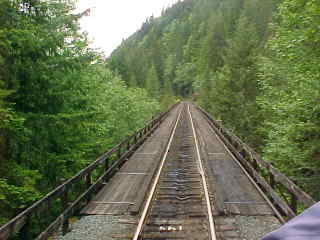
The Big Baldwin Bridge trestle is 500 feet long and 185 feet above the creek, with makeshift water tanks on each end. That was even more of an impressive trestle.


A few minutes later we emerged from Tunnel 27 onto the tightly-curved wooden Wolf Creek Trestle at Milepost 803.7, on a three percent grade on a horseshoe curve. The Pacific Railway and Navigation Company (later Southern Pacific) certainly knew how to build wooden trestles. Everyone was served their boxed lunches as we passed through Tunnels 28 and 29 while crossing small creeks in between.

We continued on, passing through Tunnel 30 at Milepost 806.7 as we paralleled the beautiful Salmonberry River.

Running along the Salmonberry River, a tributary of the Nehalem River, about 20 miles long which drains a remote unpopulated area of the Northern Oregon Coast Range in the Tillamook State Forest about 65 miles west-northwest of Portland. It rises in northeastern Tillamook County, near its border with Washington County, and flows west-northwest through the mountains, joining the Nehalem from the southeast about 15 miles northeast of the city of Nehalem. The river's name comes from the salmonberry plant, Rubus spectabilis.

We then crossed Belding Creek at Milepost 807 and North Fork, as well as passing through Tunnels 32, 34, 35 and 36. Exiting from Tunnel 36, our special had reached Enright.
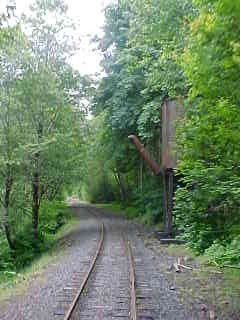
Now my new mileage would start. The train went below the water tower at Enright then crossed the Salmonberry River.

Crossing the Salmonberry River at Milepost 814.2

Later we crossed the Nehalem River, at Milepost 815.8, at the junction with the Salmonberry River and our route would now follow the Nehalem River.
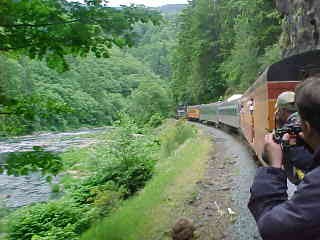
We were able to see logging by helicopter, which kept everyone in the open car entertained.

The Nehalem River, approximately 119 miles longm which drains part of the Northern Oregon Coast Range northwest of Portland, originating on the east side of the mountains and flowing in a loop around the north end of the range near the mouth of the Columbia River. Its watershed is 855 square miles and in its upper reaches, it flows through a long narrow valley of small mountain communities but is unpopulated along most of its lower reaches inland from the coast.
It rises in the northeast corner of Tillamook County, in the Tillamook State Forest and initially flows northeast, across the northwest corner of Washington County and into western Columbia County, past Vernonia where it receives Rock Creek, it hooks to the northwest and west into Clatsop County, then flows southwest back into northern Tillamook County. It enters Nehalem Bay on the Pacific in an estuary at Nehalem, about 70 miles west-northwest of Portland. Near its mouth on the Pacific, the river passes under US Route 101. It receives the Salmonberry River from the east in northern Tillamook County and also receives the North Fork Nehalem River 25 miles from the north about two miles northwest of Nehalem, just before entering Nehalem Bay.

The view looking back.

At Batterson, Milepost 825.1, we met the eastbound freight with POTB GP9 101, ex. Idaho Northern & Pacific Railroad 101, exx. Huron Eastern 101, nee Chesapeake and Ohio 6066 built by Electro-Motive Division in 1956, in a Holstein- inspired paint scheme.

Here we set out POTB SD9 4405, ex. Southern Pacific 4405 1975, exx. Southern Pacific 3899 1965, nee Southern Pacific 5421 built by Electro-Motive Division in 1955, which would be added to the eastbound freight.

Back on the move, the valley opened up and dairy farming took over.

Our crossing of the Nehalem River on a 707 foot long combination structure made up of a 313 foot trestle, a 208 foot steel span across the river, then 186 feet of trimber trestle spans.

We then passed through Wheeler, where the Nehalem Bay Winery and the POTB excursion train is kept.
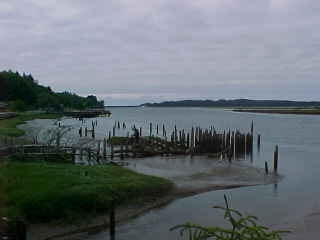
Nehalem Bay.

Nehalem Bay with Wheeler behind.
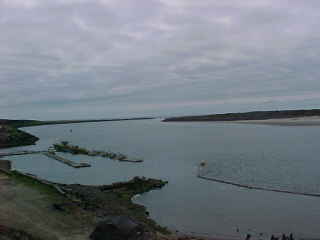
The Nehalem River meets the Pacific Ocean.

Later we passed through Rockaway Beach at Milepost 840.9.

Driftwood on Rockaway Beach.

The train rolled south next to US Highway 101 then passed through Twin Rocks, where the unique rocks could not be photographed from the train.

Passing Ocean Lake Park at Milepost 842.2 on the way to Garibaldi.
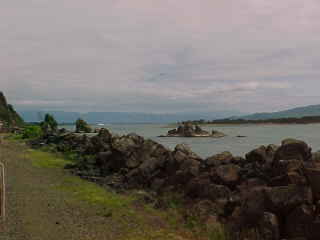
Rocks at the mouth of Tillamook Bay.

Tillamook Bay before we stopped at Lumberman's Park in Garibaldi.
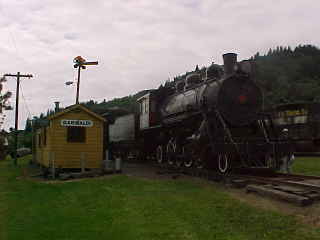
Polson Logging Company 2-8-2 90, ex. Oregon Memorial Steam Train Association 90 1963, exx. Rayonier Incorporated 90 1945, nee Polson Logging 90 built by Baldwin in 1926. In 1891, Nova Scotian immigrant Alex Polson joined with his brother Robert to start the Polson Brothers Logging Company. By 1900, they were well-established, with a short stretch of railroad to the north of Hoquiam and a log dump on the Middle Fork of the Hoquiam River.
By 1910, the company had expanded and was widely recognised as the largest logging operation in the world. Its extensive railroad network linking twelve logging and construction camps with more than one hundred miles of track, allowing an annual dump of as much as 300 million board feet of logs into the Hoquiam River for transport to Harbor mills. When Polson sold their entire operation in 1948 to Rayonier, Incorporated, 90 continued to operate out of Railroad Camp until 1962, when it was sold to the Oregon Memorial Railroad Society. It is now on display just off American Avenue.




Our special train.

We all reboarded and then our train circled Garibaldi Bay.

We went under US Highway 101 and by an inland bay.

Bart and Sarah Jennings, our trip organizers.
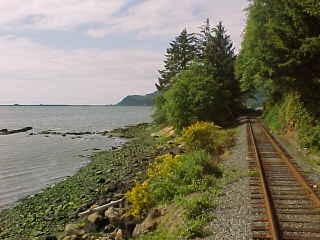
After we passed under Highway 101 again, we paralleled Tillamook Bay.

Passing between the trees.


The Kilchis River crossing at Milepost 852.7. At one time, a one-mile trestle was used to cross the river which starts up on Cedar Butte, twenty miles directly east of Twin Rocks. The Kilchis River is named for the Kilchi, the chief of the Indians of the Tillamook Bay Region, who was friendly to the whites.

The Tillamook Cheese Factory.

We arrived at Tillamook where everyone detrained to board the bus back to Banks. As always, a special thank you to Bart and Sarah Jennings, our trip organizers.
We said our goodbyes before driving back to Hillsboro where we had dinner at Elmer's and I had a King Prime Rib meal. After dinner, we went to Radio Shack for more floppy discs for my camera then returned to the Dunes Motel for the night.
| RETURN TO THE MAIN PAGE |